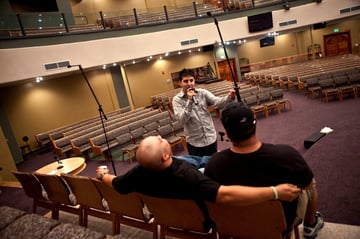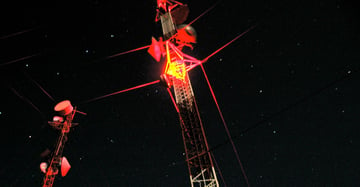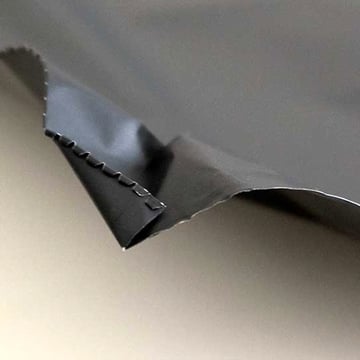
This post is the third in a series on understanding, finding, and mitigating interference for operators of wireless audio equipment.
So far, we’ve only talked about ways of understanding and categorizing interference. Now, it’s time to get busy.
We will limit our discussion here to finding methods for interference stemming from unintentional radiators, which include any man made devices that accidentally or unnecessarily emit electromagnetic energy that creates harmful interference to nearby radio equipment. We talked about these last time, but as a quick review, nearly anything device that uses electricity is a potential unintentional radiator: power lines, spark plugs, thermostats, TV screens, blenders, all are common candidates, and there are many, many more.
Finding interference that comes from intentional radiators is more difficult—and in some cases, pointless—so that will have to wait for a different post.
There are two practical finding methods that you have at your disposal. One requires a microphone receiver or other radio, and a directional antenna. The other requires only a radio.
You probably know where I’m going with the directional antenna idea. Directional antennas have high gain, and a narrow coverage pattern that is focused in a particular direction, while rejecting off axis signals. Directional antennas can be used like a flashlight: projecting a cone of coverage that illuminates the source of interference.
Using a paddle/LPDA antenna, or for even more directionality a helical like our CP Beam, one can swing the antenna in different directions, listening as the interference crackles up or quiets down depending on where you point. The direction with the loudest interference is the direction where the interference is coming from.
This is how scientists sometimes track wildlife tagged with mobile VHF transmitters. Using a highly directional antenna and a receiver tuned to the transmitter’s frequency, a user sweeps the antenna back and forth across the landscape, and the receiver beeps when the coverage pattern of the antenna picks up the transmitter’s signal, and remains silent when the transmitter is outside coverage. The leading image shows a wildlife officer scouring the rolling hills of Northern California for deer using a Yagi type antenna and a dedicated wildlife receiver.
 Portable VHF receiver and directional antenna.
Portable VHF receiver and directional antenna.
The directional finding technique is probably the easiest, but it doesn’t disclose the source’s proximity. Another method called frequency dependent attenuation exploits the fact that unintentional radiators are characteristically broadband, and that lower frequencies carry farther than higher. When something releases unintentional RFI, it usually does so across a broad swatch of frequencies, which could be one, ten, or hundreds of MHz wide, whereas an intentional signal or collection of signals is usually very narrow by comparison.
The broadband nature of spurious unintentional interference is what makes it so disabling, but it also gives sleuths a leg up on interference. The physical distance traveled by an electromagnetic wave is inversely proportional to its frequency. For example, a wave of 500 MHz may be able to reach a receiver 100 feet away, while a wave at 250 MHz of the same amplitude might travel 400 feet, and so forth. There are many factors that change how far a wave can travel, including transmission power, gain of transmitting antenna, air density and temperature—but you get the picture.
Since unintentional radiators emit broadband interference, the same source can be heard across many frequencies. But since lower frequencies (that oscillate fewer times per second) travel farther than higher frequencies, the farther away the listening radio is from the source of interference, the fewer high frequencies can be heard.
Imagine there’s an old mercury thermostat in the bowels of a theater somewhere. At the source, this thermostat pushes out strong, broadband RFI from the top of the UHF band (698 MHz) all the way down to below the bottom of VHF (54 MHz), and even below that still. A wireless microphone receiver up in the booth is getting strong interference around 500 MHz.
In practice, a hunter would tune their receiver to the highest frequency that the interference can be heard, and move about, continually tuning upward in frequency, listening for the interference on those higher frequencies. If the interference is heard on progressively higher frequencies, then the interference source is closer. Keep moving and retuning into higher frequencies until the source is found.
In the theater example, the user could tab up through the preset frequencies throughout the receiver’s range, starting at 550 MHz, while moving around. As the interference gets higher and higher, the thermostat draws closer. Maybe it’s in the basement, or up on the cat.
A dedicated microphone receiver can be used with this method, and is most likely ideal since it is tuned to the same frequency range that microphones use. However, receivers aren’t always built to be mobile. And even if they are, rack mounts make this method impractical.
An inexpensive and convenient interference hunting substitute receiver is a handheld analog transistor radio. They’re small, light, and portable, and the analog dial facilitates frequent retuning. At the very least, they give you two frequency bands to play with: medium wave AM (531-1611 kHz), and broadcast FM (87.5-108 MHz). There are plenty of cheap, vintage VHF analog radios to be found on eBay—although UHF models are rare.
Leading image courtesy California Department of Fish and Wildlife.
Alex Milne
Alex Milne was Product Marketing Manager and Digital Marketing Manager for RF Venue, and a writer for the RF Venue Blog, from 2014-2017. He is founder and CEO of Terraband, Inc., a networking and ICT infrastructure company based in Brooklyn, NY., and blogs on spectrum management, and other topics where technology,...
More from the blog

Five Wireless Mistakes Holding Church Techs Back From Great Audio

Is the Reign of the UHF Microphone Coming to an End?

4 Proven Strategies for Fighting Video Wall RF Interference
Subscribe to email updates
Stay up-to-date on what's happening at this blog and get additional content about the benefits of subscribing.


 Small 70's transistor radio.
Small 70's transistor radio.